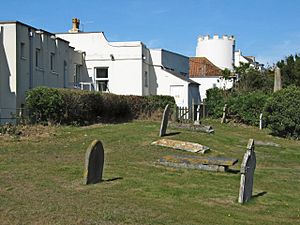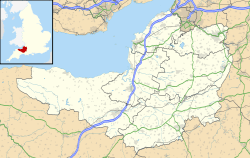Burnham-on-Sea Round Tower facts for kids
 |
|
| Burnham-on-Sea Round Tower | |
|
|
|
| Location | Burnham-on-Sea Somerset England |
|---|---|
| Coordinates | 51°14′24″N 2°59′55″W / 51.239978°N 2.998627°W |
| Year first constructed | 1801 |
| Deactivated | 1832 |
| Construction | masonry tower |
| Tower shape | cylindrical tower with battlement top |
| Markings / pattern | white tower |
| ARLHS number | ENG-323 |
The Round Tower was an old lighthouse located in Burnham-on-Sea, a town in Somerset, England. It was built in 1801 to help guide ships safely. However, it stopped being used as a lighthouse in 1832. This happened because new, brighter lights were built nearby. Today, the Round Tower is a private home.
Contents
Where is the Round Tower?
Burnham-on-Sea is famous for its wide beach and mudflats. These are common in Bridgwater Bay and the wider Bristol Channel. At low tide, the water can go out for more than 1.5 miles (2.4 km).
The Bristol Channel's Tides
Burnham is near where the River Parrett flows into the Bristol Channel. The Bristol Channel has the second highest tidal range in the world. This means the difference between high tide and low tide is huge, about 15 metres (49 ft)! Only the Bay of Fundy in Eastern Canada has a bigger tidal range.
Why a Lighthouse Here?
The constantly moving sands in this area have always been very dangerous for ships. This is why a lighthouse was so important here.
History of the Round Tower
The story of the Round Tower lighthouse began long before it was built.
The First Light
Local stories say that around 1750, a fisherman's wife put a candle in her window. She did this on a stormy night to guide her husband's boat home. It worked so well that other sailors started paying her. They wanted her to keep a candle burning every night.
Later, the sexton (a church official) of St Andrews Church took over. He was paid £5 to keep the light going. He moved the light to the top of the church tower so it could be seen better.
Building a Proper Lighthouse
Towards the end of the 1700s, a local vicar, The Revd David Davies, decided to build a proper lighthouse. He paid the sexton £20 for the right to show the light. The new lighthouse, called the Burnham (or Bridgwater) Lighthouse, was built next to the curate's house. Its light first shone in 1801.
Money to keep the light working came from local business owners and ship captains. But by 1813, this money wasn't enough. So, Revd Davies was allowed to collect special fees, called dues, from ships. This helped cover the £135 needed each year for the lighthouse's upkeep.
Changes in Ownership
Around 1829, a group called Trinity House bought the remaining 85 years of the lighthouse's lease. Trinity House is the official authority for lighthouses in England. Revd Davies used the money from this sale to improve the local area. He hoped to turn Burnham into a 'spa town' called 'Daviesville'.
How the Light Worked
In 1831, the lighthouse's light was described as very special. It would shine brightly like a star for one and a half minutes. Then, it would go dark for half a minute. This was called an occulting characteristic. The light was on all night and could be seen from far away.
A New Era for Lighthouses
Trinity House soon decided to replace the old lighthouse. They planned to build a much taller and more elegant structure. This new lighthouse would be about half a mile north of the old one. Because it was taller and had a clear view, it could be seen from a much greater distance.
At the same time, they planned a second light closer to the water. These two new lights would work together as leading lights. This means they would guide ships along a safe path.
Trinity House kept the old Round Tower lighthouse working until December 1, 1832. On that day, it was turned off for good. The new High and Low lighthouses were lit instead. The special machinery that made the old light flash was moved to the new High Light.
Later, the old Round Tower was made shorter, down to two stories. This was to make sure no one confused it with the new, taller High Lighthouse. Battlements (like those on a castle) were added to its top.
Why the Round Tower Was Important
In 1836, a doctor named George Henning wrote a guide about the new spa town. He said the Round Tower lighthouse was "the great feature of the place." He called it "the cynosure of the waters," meaning it was the main attraction. He believed that building this lighthouse was what made Burnham famous. It brought visitors to the town, and smart people saw that it was a place with a lot of promise.


